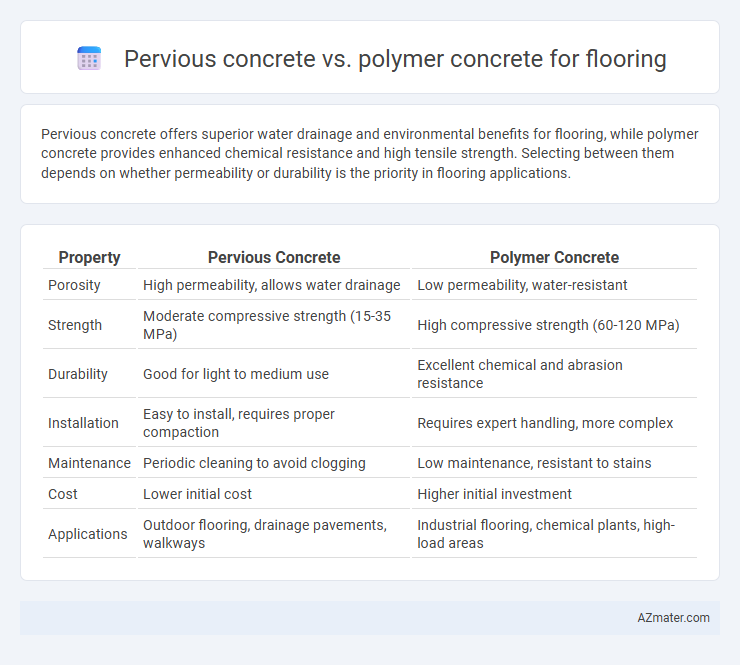Pervious concrete offers superior water drainage and environmental benefits for flooring, while polymer concrete provides enhanced chemical resistance and high tensile strength. Selecting between them depends on whether permeability or durability is the priority in flooring applications.
Table of Comparison
| Property | Pervious Concrete | Polymer Concrete |
|---|---|---|
| Porosity | High permeability, allows water drainage | Low permeability, water-resistant |
| Strength | Moderate compressive strength (15-35 MPa) | High compressive strength (60-120 MPa) |
| Durability | Good for light to medium use | Excellent chemical and abrasion resistance |
| Installation | Easy to install, requires proper compaction | Requires expert handling, more complex |
| Maintenance | Periodic cleaning to avoid clogging | Low maintenance, resistant to stains |
| Cost | Lower initial cost | Higher initial investment |
| Applications | Outdoor flooring, drainage pavements, walkways | Industrial flooring, chemical plants, high-load areas |
Introduction to Pervious Concrete and Polymer Concrete
Pervious concrete is a highly porous material designed to allow water to pass through, reducing runoff and improving groundwater recharge, making it ideal for sustainable flooring applications. Polymer concrete incorporates polymer binders instead of traditional cement, offering superior chemical resistance, increased durability, and faster curing times compared to conventional concrete. Both materials provide unique advantages in flooring solutions, with pervious concrete excelling in permeability and polymer concrete in strength and environmental resistance.
Key Material Properties Compared
Pervious concrete exhibits high porosity, allowing water permeability and effective stormwater management, with compressive strength typically ranging from 2000 to 4000 psi, making it suitable for sustainable flooring solutions. Polymer concrete features superior chemical resistance, low shrinkage, and higher tensile strength, often exceeding 6000 psi, ensuring enhanced durability and long-term performance in industrial flooring applications. Both materials differ significantly in thermal expansion and curing time, where polymer concrete offers faster curing and better resistance to freeze-thaw cycles compared to pervious concrete.
Installation Process Differences
Pervious concrete installation requires careful layering and compaction to maintain its porous structure, enabling effective water drainage and reducing surface runoff. Polymer concrete installation involves mixing resins with aggregates and curing under controlled conditions, resulting in a faster set time and higher chemical resistance suitable for industrial flooring. The installation of polymer concrete often demands specialized equipment and skilled labor compared to the more conventional placement and finishing methods used for pervious concrete.
Permeability and Drainage Capabilities
Pervious concrete offers superior permeability and drainage capabilities due to its porous structure, allowing water to pass through and reducing surface runoff. Polymer concrete, while denser and less permeable, provides enhanced chemical resistance and mechanical strength but is less effective in managing drainage. For flooring applications requiring efficient water drainage and permeability, pervious concrete is the optimal choice.
Mechanical Strength and Durability
Pervious concrete offers excellent drainage capabilities but generally exhibits lower compressive strength, typically ranging from 2,500 to 4,000 psi, making it less durable under heavy mechanical loads compared to polymer concrete. Polymer concrete, composed of resins binding aggregates, achieves superior mechanical strength, often exceeding 8,000 psi, and demonstrates enhanced chemical resistance and durability in harsh environments. This makes polymer concrete a preferred choice for flooring applications requiring high load-bearing capacity and long-term wear resistance.
Maintenance and Longevity
Pervious concrete offers superior drainage and reduces surface water accumulation, but it requires regular cleaning to prevent clogging and maintain permeability, impacting its long-term maintenance. Polymer concrete boasts higher chemical resistance and durability, leading to lower maintenance needs and extended lifespan in floors exposed to harsh conditions. While polymer concrete generally lasts longer due to its enhanced mechanical properties, proper upkeep of pervious concrete can sustain its functionality in environmental control applications.
Environmental Impact and Sustainability
Pervious concrete offers significant environmental benefits by promoting groundwater recharge and reducing stormwater runoff, which helps mitigate urban flooding and supports sustainable water management. Polymer concrete boasts enhanced durability and chemical resistance, extending flooring lifespan and minimizing the frequency of repairs and replacements, thus reducing material waste. Both materials contribute to sustainability, but pervious concrete's role in water conservation makes it particularly advantageous for eco-friendly flooring solutions.
Cost Comparison: Initial and Lifecycle
Pervious concrete typically has a lower initial installation cost compared to polymer concrete due to the use of conventional materials and simpler mixing processes. Lifecycle costs for pervious concrete may increase over time because of maintenance needs related to clogging and reduced permeability, whereas polymer concrete offers higher durability and chemical resistance, reducing long-term maintenance expenses. Selecting between the two involves balancing the lower upfront investment of pervious concrete against the extended lifecycle savings and enhanced performance of polymer concrete.
Best Applications for Each Concrete Type
Pervious concrete excels in applications requiring enhanced drainage and stormwater management, making it ideal for parking lots, walkways, and low-traffic outdoor flooring where water permeability is critical. Polymer concrete, known for its superior chemical resistance and rapid curing, is best suited for industrial flooring, chemical plants, and areas subject to heavy mechanical stress or corrosive substances. Selecting between pervious and polymer concrete depends on environmental exposure, load requirements, and maintenance priorities specific to each flooring project.
Conclusion: Choosing the Right Flooring Solution
Pervious concrete offers superior water drainage and environmental benefits, making it ideal for outdoor and permeable flooring applications. Polymer concrete provides exceptional chemical resistance and durability, suited for industrial or high-traffic indoor environments. Selecting the right flooring depends on specific project requirements, including load-bearing needs, exposure to chemicals, and desired permeability.

Infographic: Pervious concrete vs Polymer concrete for Flooring
 azmater.com
azmater.com